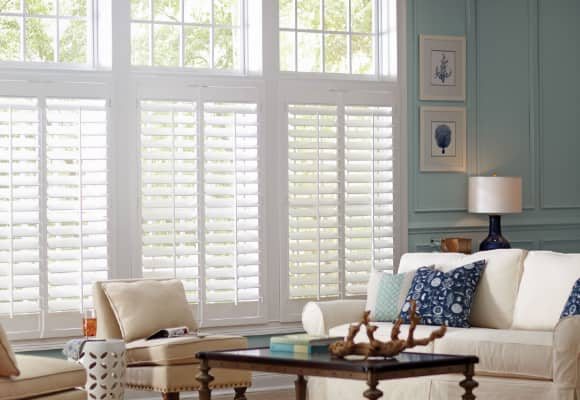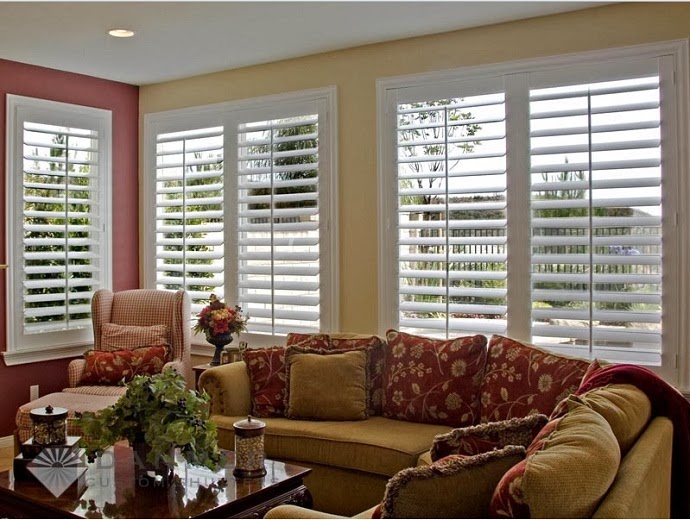Style Your Home With Decorative Plantation Shutters
Choosing plantation shutters for form or function? Plantation shutters offer both to todays homeowner. These unique window treatments trace their roots to ancient Greece. The Greeks used them for both privacy and security. Interior shutters were used to close windows. Along with imposing columns, shutters are hallmarks of Classical Greek Architecture. This ancient order and form in building design later influenced buildings and architecture throughout the Western world.Before the widespread use of glass, shutters were used to close windows. They were used to protect the interior of the house from the weather and from intruders as well as provide privacy. They could be opened to allow sunlight and fresh air into the building or home.
Elements of Greek architecture are seen in many buildings and homes from the late 18th century, the 19th century and the early 20th century in the United States. It was especially prevalent in banks, office buildings and many public and government buildings. The plantation mansions of the old South borrowed heavily on the architecture of the Greeks. The antebellum mansions of the great plantations from South Carolina to the western edge of Mississippi borrowed heavily from the building concepts of the Greeks. A number of these grand old mansions have been restored and preserved at Natchez, Mississippi.
Just as did the ancient Greeks, plantation owners used shutters for both their beauty and their function. By closing the windows in this manner, these homeowners were able to add a level of security to their homes. This was important because in the era before the Civil War, the agricultural areas of the South were only sparsely populated. Plantations were largely isolated. Plantations were also symbols of wealth, making them targets for bands of robbers. There was also the potential of attack from revolting slaves.
Times have changed and todays homeowners use shutters primarily for their beauty or form rather than for security.
What are plantation shutters?
Plantation shutters are louvered interior shutters. They cover the entire window. They are most often made from wood, although modern materials including PVC and vinyl are also being used with growing acceptance. The shutters are hinged and can be opened or closed and latched. In addition to swinging open, some models have moveable louvers that can be opened and closed. Other models have stationary louvers. There is great flexibility in being able to partially or completely open the shutters and/or partially or completely open the louvers. This allows tremendous control in directing the inflow of outside air as well as sunlight.
Typically the panels of plantation shutters range from 15 inches to 36 inches wide. Louvers are available in several widths, ranging from 1-3/4 inches wide to 4-1/2 inches wide, appealing to different tastes and fitting with a variety of decors. The width of the louver has a practical application as well as aesthetic. The wider the louver, the more air or sunlight will be allowed to filter through.
These shutters are often used in series. Rooms with a number of windows, several adjacent windows or large picture windows look especially good with plantation shutter window treatment.
Pine is frequently used in construction of hurricane shutters as well. Contractors and do-it-yourselfers can find them both pre-finished and unfinished. Unfinished allows the contractor or diy to finish with any paint or stain color desired.
PVC and vinyl panels come in colors, including white. These panels may be plain or have embossed wood graining. PVC and vinyl are excellent choices for rooms where there can be high levels of moisture or steam. They are good for pool rooms, bathrooms and utility rooms.
Shutters with moveable panels have the added advantage of providing privacy at the same time they admit light and air. You can adjust the louvers in such a manner that light and air is allowed into the room while at the same time preventing outside passersby from seeing inside.
Some tips for selecting shutters for your home
1. Consult your carpenter or contractor. Determine if the present window casings will support the weight of the hinged shutters when opened and closed, or whether additional framing will be required.
2. Consider the width of the louver. The louver width affects the appearance as well as the function of the shutters. The wider the louver, the more light and air will be permitted to flow into the room.
3. Choose between wood and vinyl. Wooden, especially faux wood shutters can give the room a warmer feeling. Vinyl shutters work well in rooms that have high moisture or steam content. Vinyl shutters are easy to clean and will not warp.
4. Choose between moveable and fixed louvers. If you want to use the shutters primarily for privacy and security, you may wish to use fixed position louvers. If you want to be able to open the shutters to admit light, ventilation or see through the window, you will want to select adjustable louver shutters.
5. Read the reviews written by home improvement consultants and also by consumers. These reviews are posted on websites and are published on home improvement websites and in home decorating magazines.
6. Choose a reputable company with a reliable warranty against defects in materials and workmanship.
Tips for installing shutters
1. Measure the window and make sure that the window opening is square. If the window is not square, you will be required to taper the shutter to fit the opening.
2. Cut the shutters to fit the opening. If you cannot find a shutter that will fit your window exactly, choose a shutter that is slightly larger than the opening. If you need to trip more than ¾ from the shutter, cut all of it from the left or bottom sides. If you need to trim more than ¾ inch from the side, cut half from each side. Use the same procedure in trimming the height of the shutter.
3. Hinge the shutter with non-mortising hinges. Use two shutter hinges for shutters 30 inches or less in height. Use three hinges for shutters from 30 48 inches high. Be sure and place the hinges on the opposite side of the desired shutter opening.
4. Install the latch on the opposite side of the hinges. The latch is often installed in the centre of the shutter. In some applications it may be desirable to install the latch near the top or the bottom of the shutter. For example, in a room used by small children you may wish to install the latch near the top of the shutter.
5. The installation tools needed include a mitre, radial arm or table saw; a jointer, planer or a hand plane; screwdriver; square, paint brush; tape measure; pencil; the shutters, non-mortising hinges, screws, fine sandpaper and touch-up paint or varnish.
Todays homeowner is going to use plantation shutters more for beauty, but they are also important for privacy and security. Shutters are often an excellent choice for living rooms, sitting rooms, dens, home libraries and home offices. There is a special feeling that comes from sitting or working in a room dominated by the rich warmth of wood. Sunlight, ventilation and artificial lighting can all be adjusted to provide just the right atmosphere.








0 Response to "Style Your Home With Decorative Plantation Shutters"
Post a Comment